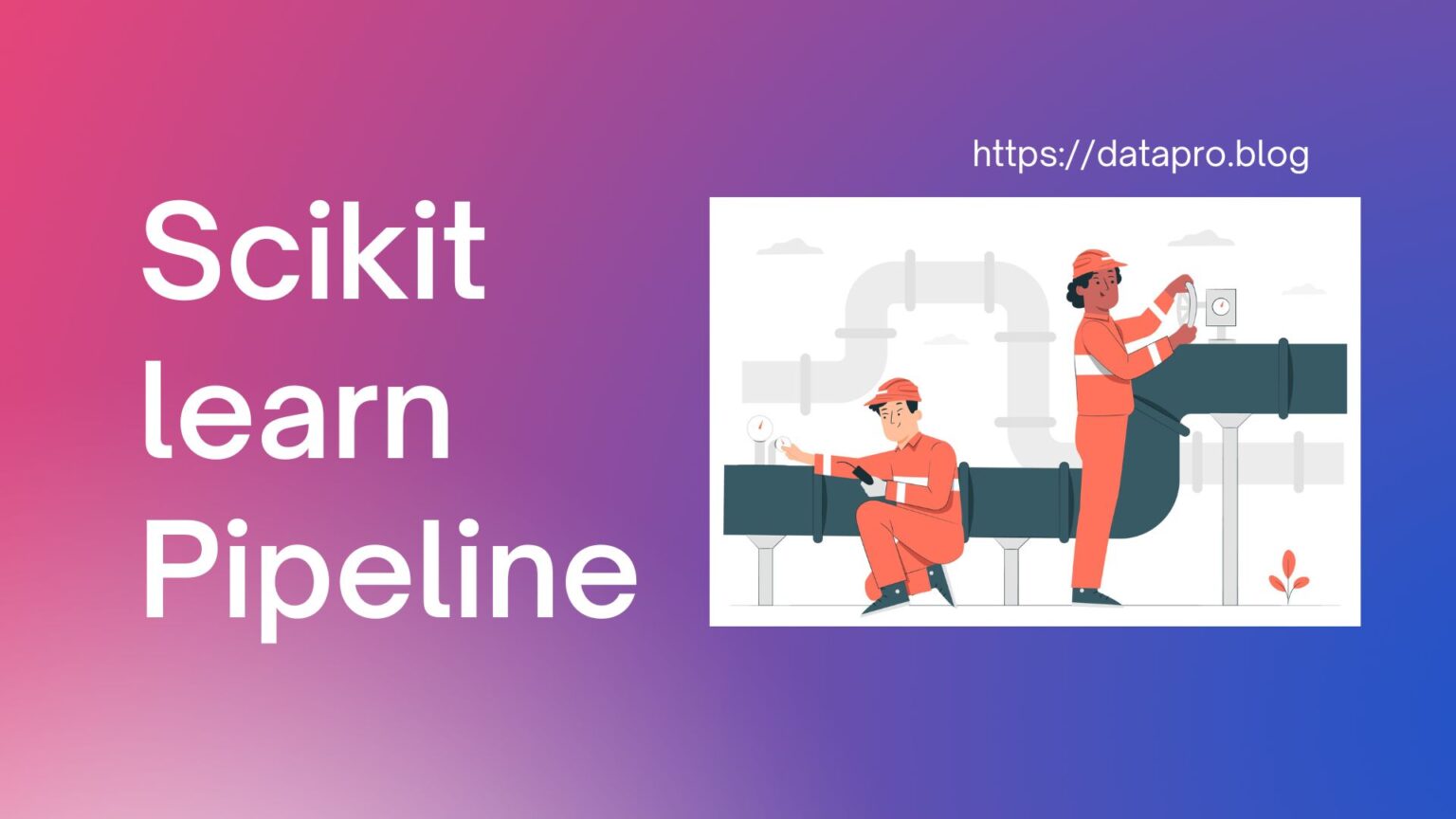Machine learning is a complex and iterative process that involves multiple steps, such as data collection, preprocessing, feature engineering, model selection, training, evaluation, and deployment. Each step requires careful planning and execution, as well as coordination and communication with other steps. However, managing and maintaining such a workflow can be challenging, especially when working with large and diverse datasets, multiple models, and different parameters.
This is where sklearn pipeline comes in handy. Sklearn pipeline is a class in the popular scikit-learn library that allows you to create and use a sequence of data transformation and modeling steps as a single object. With sklearn pipeline, you can:
- Simplify and standardize your code by encapsulating and automating the entire data transformation and modeling process in one place.
- Ensure data consistency and avoid data leakage by applying the same transformations to both the training and testing data.
- Streamline and optimize your model selection and tuning by combining pipelines with other scikit-learn objects, such as feature union, grid search, cross-validation, and pipeline visualizer.
In this article, we will explore what sklearn pipeline is and how to use it in your machine learning projects. We will also discuss some common issues or pitfalls that can arise when working with machine learning code, and how pipelines can help you avoid or solve them. By the end of this article, you will have a better understanding of the benefits and challenges of using pipelines in scikit-learn, and how to leverage them to improve your machine learning code quality and performance.
Table of Contents
How to create and use pipelines in scikit-learn?
In this section, we will learn how to create and use pipelines in scikit-learn. A pipeline is an object that takes a list of steps as an argument, where each step is a tuple of a name and an estimator or transformer. An estimator is an object that can fit and predict data, such as a classifier or a regressor. A transformer is an object that can transform data, such as a scaler or a selector.
To create a pipeline, we need to import the Pipeline class from the sklearn.pipeline module. Then, we can instantiate a pipeline object with the desired steps. For example, suppose we want to create a pipeline that performs the following steps:
- Standardize the features using the
StandardScalertransformer from thesklearn.preprocessingmodule. - Reduce the dimensionality using the
PCAtransformer from thesklearn.decompositionmodule. - Classify the data using the
LogisticRegressionestimator from thesklearn.linear_modelmodule.
We can create such a pipeline as follows:
# Import the necessary modules
from sklearn.pipeline import Pipeline
from sklearn.preprocessing import StandardScaler
from sklearn.decomposition import PCA
from sklearn.linear_model import LogisticRegression
# Create a list of steps
steps = [
('scaler', StandardScaler()),
('pca', PCA(n_components=2)),
('logreg', LogisticRegression())
]
# Instantiate a pipeline object
pipe = Pipeline(steps)We can access and modify the pipeline steps, parameters, and attributes using the dot notation or the indexing notation. For example, we can get the names of the steps as follows:
# Get the names of the steps
pipe.named_steps.keys()Output
dict_keys(['scaler', 'pca', 'logreg'])We can also get the parameters of a specific step as follows:
# Get the parameters of the pca step
pipe.named_steps['pca'].get_params()Output
{'copy': True,
'iterated_power': 'auto',
'n_components': 2,
'n_oversamples': 10,
'power_iteration_normalizer': 'auto',
'random_state': None,
'svd_solver': 'auto',
'tol': 0.0,
'whiten': False}We can also set the parameters of a specific step as follows:
# Set the solver parameter of the logreg step to 'liblinear'
pipe.set_params(logreg__solver='liblinear')Output

To use the pipeline, we need to have some data to work with. For this example, we will use the iris dataset, which is a classic dataset for classification problems. The iris dataset contains 150 samples of three different species of iris flowers, with four features each: sepal length, sepal width, petal length, and petal width. We can load the iris dataset from the sklearn.datasets module as follows:
# Import the iris dataset
from sklearn.datasets import load_iris
# Load the data and the target
iris = load_iris()
X = iris.data
y = iris.targetNow, we can fit the pipeline to the data using the fit method. This will apply each step to the data sequentially, and store the fitted parameters for each step. For example, we can fit the pipeline to the entire iris dataset as follows:
from sklearn.model_selection import train_test_split
X_train, X_test, y_train, y_test = train_test_split(X, y, test_size=0.2, random_state=42)
pipe.fit(X_train, y_train) # Fit the entire pipelineWe can also predict the labels of new data using the predict method. This will apply each step to the new data sequentially, and return the predicted labels for each sample.
y_pred = pipe.predict(X_test) # Make predictions on new dataWe can also evaluate the performance of the pipeline using the score method. This will apply each step to the data sequentially, and return the mean accuracy of the predictions. For example, we can score the pipeline on the entire iris dataset as follows:
# Score the pipeline on the data
accuracy = pipe.score(X_test, y_test) # Evaluate performance
print("Accuracy:", accuracy)Output
Accuracy: 0.9333333333333333
How to improve machine learning code quality with Sklearn pipeline?
In the previous section, we learned how to create and use pipelines in scikit-learn. In this section, we will see how pipelines can help us improve the quality of our machine learning code. We will cover the following topics:
- How pipelines can prevent data leakage and ensure data consistency?
- How pipelines can simplify and standardize our code?
- How pipelines can streamline and optimize our model selection and tuning?
How pipelines can prevent data leakage and ensure data consistency?
One of the common issues or pitfalls that can arise when working with machine learning code is data leakage. Data leakage occurs when information from the test set is used to train or tune the model, either directly or indirectly. This can lead to overfitting and unrealistic performance estimates.
For example, suppose we want to apply some data preprocessing steps, such as scaling and feature selection, before training a model. A naive approach would be to apply these steps to the entire dataset and then split it into a training set and a test set. However, this would cause data leakage, because the preprocessing steps would use information from the test set, such as the mean and standard deviation for scaling, or the feature importance for selection.
A better approach would be to split the dataset into a training set and a test set first, and then apply the preprocessing steps separately to each set. However, this would require writing more code and ensuring that the same steps and parameters are applied consistently to both sets.
This is where pipelines can help us. By using pipelines, we can encapsulate and automate the entire data transformation and modeling process in one object. We can fit the pipeline to the training set, and then apply it to the test set, without worrying about data leakage or inconsistency. For example, we can create a pipeline that performs scaling, feature selection, and classification as follows:
# Import the necessary modules
from sklearn.pipeline import Pipeline
from sklearn.preprocessing import StandardScaler
from sklearn.feature_selection import SelectKBest
from sklearn.linear_model import LogisticRegression
from sklearn.datasets import load_wine
# Load the data and the target
X, y = load_wine(return_X_y=True)
# Create a list of steps
steps = [
('scaler', StandardScaler()),
('selector', SelectKBest(k=2)),
('logreg', LogisticRegression())
]
# Instantiate a pipeline object
pipe = Pipeline(steps)Then, we can split the dataset into a training set and a test set, and fit the pipeline to the training set as follows:
# Import the necessary module
from sklearn.model_selection import train_test_split
# Split the dataset into a training set and a test set
X_train, X_test, y_train, y_test = train_test_split(X, y, test_size=0.2, random_state=42)
# Fit the pipeline to the training set
pipe.fit(X_train, y_train)
Output

Finally, we can apply the pipeline to the test set, and evaluate the performance as follows:
# Predict the labels of the test set
y_pred = pipe.predict(X_test)
# Score the pipeline on the test set
pipe.score(X_test, y_test)Output
0.8611111111111112
By using pipelines, we can prevent data leakage and ensure data consistency, which can improve the quality and reliability of our machine learning models.
How pipelines can simplify and standardize our code?
Another benefit of using pipelines is that they can simplify and standardize our code. By using pipelines, we can reduce the amount of code we need to write and maintain, as well as make our code easier to read and understand.
For example, suppose we want to compare the performance of different classifiers on the same dataset. Without pipelines, we would need to write separate code for each classifier and repeat the same preprocessing steps for each one. This would result in a lot of redundant and messy code, which can be prone to errors and difficult to debug.
With pipelines, we can create a list of pipelines, each with a different classifier, and loop through them to compare their performance. This would result in a much cleaner and more concise code, which can be easier to modify and reuse. For example, we can create a list of pipelines with different classifiers as follows:
# Import the necessary modules
from sklearn.pipeline import Pipeline
from sklearn.preprocessing import StandardScaler
from sklearn.feature_selection import SelectKBest
from sklearn.linear_model import LogisticRegression
from sklearn.svm import SVC
from sklearn.tree import DecisionTreeClassifier
from sklearn.datasets import load_wine
# Load the data and the target
X, y = load_wine(return_X_y=True)
# Create a list of pipelines with different classifiers
pipelines = [
('logreg', Pipeline([('scaler', StandardScaler()), ('selector', SelectKBest(k=2)), ('logreg', LogisticRegression())])),
('svc', Pipeline([('scaler', StandardScaler()), ('selector', SelectKBest(k=2)), ('svc', SVC())])),
('dtree', Pipeline([('scaler', StandardScaler()), ('selector', SelectKBest(k=2)), ('dtree', DecisionTreeClassifier())]))
]Then, we can loop through the list of pipelines, and fit and score each one on the same dataset as follows:
# Import the necessary module
from sklearn.model_selection import train_test_split
# Split the dataset into a training set and a test set
X_train, X_test, y_train, y_test = train_test_split(X, y, test_size=0.2, random_state=42)
# Loop through the list of pipelines
for name, pipeline in pipelines:
# Fit the pipeline to the training set
pipeline.fit(X_train, y_train)
# Score the pipeline on the test set
score = pipeline.score(X_test, y_test)
# Print the name and score of the pipeline
print(name, score)
Output
logreg 0.8611111111111112
svc 0.8611111111111112
dtree 0.6388888888888888By using pipelines, we can simplify and standardize our code, which can improve the efficiency and readability of our machine learning projects.
How pipelines can streamline and optimize our model selection and tuning?
A third advantage of using pipelines is that they can streamline and optimize our model selection and tuning. By using pipelines, we can combine different data transformation and modeling steps into a single object, and search for the best combination of parameters for the entire pipeline.
For example, suppose we want to find the best number of features to select and the best regularization parameter for the logistic regression classifier. Without pipelines, we would need to write a nested loop to try different combinations of parameters and evaluate the performance of each one. This would result in a lot of code and computation time, which can be inefficient and tedious.
With pipelines, we can use the GridSearchCV object from the sklearn.model_selection module, which can perform an exhaustive search over a grid of parameters for the pipeline, and return the best pipeline and its score. This would result in a much simpler and faster code, which can be easier to implement and interpret. For example, we can create a pipeline with scaling, feature selection, and logistic regression as follows:
# Import the necessary modules
from sklearn.pipeline import Pipeline
from sklearn.preprocessing import StandardScaler
from sklearn.feature_selection import SelectKBest
from sklearn.linear_model import LogisticRegression
# Create a pipeline with scaling, feature selection, and logistic regression
pipe = Pipeline([('scaler', StandardScaler()), ('selector', SelectKBest()), ('logreg', LogisticRegression())])Then, we can create a grid of parameters to search over, such as the number of features to select, and the regularization parameter for the logistic regression as follows:
# Create a grid of parameters to search over
param_grid = {
'selector__k': [2, 4, 6, 8, 10],
'logreg__C': [0.001, 0.01, 0.1, 1, 10, 100]
}Finally, we can use the GridSearchCV object to perform the grid search and print the best pipeline and its score as follows:
# Import the necessary module
from sklearn.model_selection import GridSearchCV
from sklearn.datasets import load_wine
# Import the necessary module
from sklearn.model_selection import train_test_split
# Load the data and the target
X, y = load_wine(return_X_y=True)
# Split the dataset into a training set and a test set
X_train, X_test, y_train, y_test = train_test_split(X, y, test_size=0.2, random_state=42)
# Instantiate a GridSearchCV object with the pipeline and the parameter grid
grid = GridSearchCV(pipe, param_grid, cv=5)
# Fit the grid to the data
grid.fit(X_train, y_train)
# Print the best pipeline and its score
print(grid.best_estimator_)
print(grid.best_score_)Output
Pipeline(steps=[('scaler', StandardScaler()), ('selector', SelectKBest(k=8)),
('logreg', LogisticRegression(C=0.1))])
0.9790640394088669By using pipelines and GridSearchCV, we can streamline and optimize our model selection and tuning, which can improve the accuracy and robustness of our machine learning models.
Conclusion
In this article, we have learned what the sklearn pipeline is and how to use it in our machine learning projects. We have also seen how pipelines can help us improve the quality of our machine learning code by preventing data leakage, simplifying and standardizing our code, and streamlining and optimizing our model selection and tuning. We have provided some code examples of how to create and use pipelines with different steps and parameters, as well as how to combine pipelines with other scikit-learn objects, such as feature union, grid search, cross-validation, and pipeline visualizer.
Sklearn pipeline is a powerful tool that can make our machine learning workflow easier and more efficient. By using pipelines, we can encapsulate and automate the entire data transformation and modeling process in one object, and search for the best combination of parameters for the whole pipeline. Pipelines can also help us avoid common issues or pitfalls that can arise when working with machine learning code, such as data leakage, code duplication, and parameter tuning.
We hope this article has given you a better understanding of the benefits and challenges of using pipelines in scikit-learn, and how to leverage them to improve your machine learning code quality and performance.
Frequently Asked Questions
What is the purpose of sklearn pipeline?
Sklearn pipeline is a tool that allows you to create and use a sequence of data transformation and modeling steps as a single object. It can simplify and standardize your code, prevent data leakage, and streamline and optimize your model selection and tuning.
How do you use sklearn pipeline?
To use sklearn pipeline, you need to import the Pipeline class from the sklearn.pipeline module, and then instantiate a pipeline object with a list of steps, where each step is a tuple of a name and an estimator or transformer. You can then fit, predict, and score the pipeline on your data, as well as access and modify the pipeline steps, parameters, and attributes.
What is the difference between pipeline and ColumnTransformer in sklearn?
Pipeline and ColumnTransformer are both tools that can help you combine different data transformation and modeling steps into a single object. However, the pipeline applies the same steps to the entire dataset, while ColumnTransformer applies different steps to different columns or subsets of the dataset.
How do you create a custom transformer in sklearn pipeline?
To create a custom transformer in sklearn pipeline, you need to define a class that inherits from the BaseEstimator and TransformerMixin classes from the sklearn.base module, and implement the fit and transform methods. You can then use your custom transformer as a step in your pipeline.
How do you visualize a sklearn pipeline?
To visualize a sklearn pipeline, you can use tools such as pipeline-viz, jx-pipelines-visualizer, or pipelines visualizer UI, which can generate clear and interactive visual representations of your machine learning pipelines. You can see the structure, parameters, and performance of your pipelines, as well as the data flow and dependencies between the steps.




